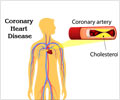Prevention of coronary heart disease in women is less than men and the risk factor management of coronary heart disease varies in both men and women.

‘There is a need for tailored strategies to reduce these inequalities and to improve the uptake of guideline-recommended care for the secondary prevention of CHD in both men and women.’





Coronary heart disease (CHD) remains one of the leading causes of death and disability worldwide. Despite convincing evidence on the benefits of managing risk factors in people with established CHD (such as lowering blood pressure and cholesterol levels and being physically active) an unacceptably large proportion of affected individuals do not reach recommended risk factor targets.So a team of international researchers set out to investigate whether there are sex differences in risk factor management of patients with established CHD, and explore some of the reasons behind this.
They analysed data from just over 10,000 patients (29% women) with CHD from Europe, Asia, and the Middle East between 2012-2013. On average, women were 4 years older than men. Adherence to guideline-recommended treatment and lifestyle targets was recorded as a Cardiovascular Health Index Score (CHIS).
Overall, only 6 percent of women and 8 percent of men reached all treatment targets and about one-third of men and women met all lifestyle targets.
After adjusting for several factors that could have influenced the results, they found that, compared with men, women were less likely to achieve targets for total cholesterol (8% vs 14%), LDL cholesterol (22% vs 33%) and blood glucose (71% vs 76%), or to be physically active or non-obese. In contrast, women had better control of blood pressure (45% vs 38%) and were more likely to be a non-smoker than men.
Advertisement
Sex disparities in reaching treatment targets were smaller in Europe than in Asia and the Middle East. Women in Asia were more likely than men to reach all lifestyle targets, but the reverse was seen in Europe and the Middle East.
Advertisement
The authors outline some possible reasons for these differences. For example, women are more likely to be underdiagnosed and are less likely to take medication, such as statins, than men.
They conclude that risk factor management for the secondary prevention of CHD was generally worse in women than in men, and the magnitude and direction of the sex differences varied by region, "suggesting the need for tailored strategies to reduce these inequalities and to improve the uptake of guideline-recommended care for the secondary prevention of CHD in both men and women."
A linked editorial by US researchers says this study adds important international data regarding sex differences in ischaemic heart disease (IHD) risk factor management.
Knowledge gaps remain, they write, and they call for further investigation into the reasons behind large sex differences in risk factor management. The need for country and region-specific IHD data stratified by sex is also needed to optimise personalised medicine, they conclude.
Source-Eurekalert















